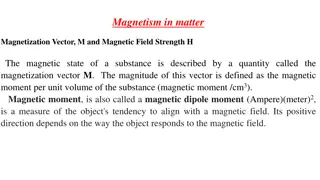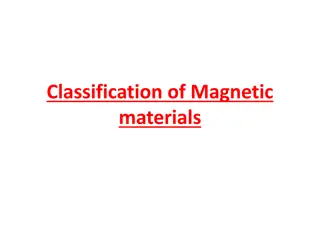Magnetic Moments and Susceptibilities in Materials
Determination of magnetic moment and susceptibility plays a crucial role in studying the magnetic properties of materials. This involves methods like Guoy balance for paramagnetic substances and observing weight changes for diamagnetic substances. The Faraday method, employing a quartz container in
1 views • 20 slides
Magnetism in Matter: Magnetization and Magnetic Field Strength
The magnetic state of a substance is characterized by the magnetization vector M, representing the magnetic moment per unit volume. The total magnetic field induction at a point within a substance depends on the applied field and magnetization M. Substances can be classified as paramagnetic, ferroma
3 views • 11 slides
Insights into Nuclear Moments and Corrections in Magnetic Interactions
Recommended values of nuclear moments are crucial for understanding magnetic dipole moments in multi-electron configurations. The hierarchy of reference moments establishes strength in magnetic interactions, with corrections to raw experimental data such as diamagnetic corrections being essential fo
0 views • 15 slides
The Classification of Magnetic Materials
The origin of magnetism lies in the orbital and spin motions of electrons, determining the magnetic properties of different materials. All matter is magnetic to some extent, with substances exhibiting diamagnetism, paramagnetism, or ferromagnetism. Diamagnetic materials oppose applied magnetic field
0 views • 24 slides
Understanding Magnetism and Magnetic Properties in Materials
Explore the principles of magnetism, magnetic susceptibility, NMR, EPR, and magnetic moments in materials with unpaired electrons. Learn about ferromagnetic, paramagnetic, and diamagnetic materials, as well as the effects of magnetic fields on them. Discover how susceptibilities and magnetic moments
0 views • 10 slides




